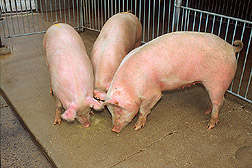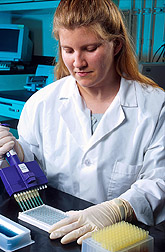Giving Pork a New Image
|
|
|
 An innovative, on-farm program to certify pigs as free of trichina parasites could become a model for excluding other meatborne diseases from foods. (K4702-6) |
The worm that makes U.S. consumers cook pork chops and roasts to the consistency of shoe leather has been on the decline for decades, thanks to changes in the way most producers manage their operations. During the last decade, for example, the percentage of U.S. swine infected withTrichinella spiralis ranged from 0 to less than 1/2 of 1 percent, depending on the pig population surveyed.
Human infections have also plunged. During the 1990s, fewer than 50 cases of human trichinellosis were reported each year to the Centers for Disease Control and Prevention, compared to 500 cases annually in the 1940s. And many of the recent cases are a result of eating bear and other game meats. |
|
 To verify the absence of Trichinella in pigs, technician Shannon Campion conducts the ARS-developed ELISA test. (K8969-1) |
Still, "pork suffers from its legacy," says Agricultural Research Service parasitologist H. Ray Gamble. The shadow of the worm not only keeps Americans overcooking fresh pork, it also closes many markets overseas.
That's about to change. Starting this summer, an innovative program for certifying pork trichinae-free based on good farm management is going through its final shakedown—a 2-year pilot study. The national certification program is expected to be a model for controlling other foodborne pathogens—including bacteria—at the source of infection, says Gamble. He heads the Parasite Biology and Epidemiology Laboratory in Beltsville, Maryland. Gamble is collaborating on the project with the National Pork Producers Council (NPPC), the meatpacking industry, and two other USDA agencies—the Animal and Plant Health Inspection Service (APHIS) and the Food Safety Inspection Service (FSIS). How It Will Work The NPPC encourages pork producers to volunteer for certification by having their operations audited by an APHIS-accredited veterinarian. APHIS will train and qualify these vets to educate producers on good management practices and to conduct the audits. Using a standardized checklist, the vets will be looking for practices that would prevent the herd's exposure to infected rodents or wildlife, such as raccoons or foxes, or to raw garbage. Given the chance, pigs will eat infected carcasses. The production sites that pass muster will be certified as having safe management practices. Participating packing plants will keep certified pigs separate from uncertified pigs and follow a protocol developed with FSIS. FSIS will confirm that the pigs from certified sites are handled separately and will also oversee spot testing of the animals to ensure they are, in fact, trichinae free. "It's a voluntary program—a first for FSIS," says John Ragan, national livestock program leader for FSIS' Animal Production Food Safety Program. Interest in such a program solidified around 1994. That's when anE. coli outbreak caused by tainted hamburgers from a fast-food restaurant heightened national interest in food safety, says Larry Miller, senior staff veterinarian with APHIS' Veterinary Services. Government and industry began to look for ways to improve safety at the farm level. "We'll run the pilot study like a bona fide program, only on a small scale, to find the bugs and fix them," Miller says. "Then, we'll scale it up incrementally." Dave Pyburn, director of veterinary science at NPPC, expects certification to begin in earnest in 2001, when the pilot study is scheduled to end. "We've designed the program with the idea that 90 to 95 percent of pork-producing sites will volunteer for the audit," he says. Gamble says the meatpackers, who want to improve their product's image, have been a driving force in supporting the concept of on-farm certification. Countries in the European Union (EU) test each pig carcass for the presence of trichinae worms—at a cost of $576 million in 1998. And they expect their trading partners to do the same. But carcass testing is too costly and cumbersome for U.S. packers, says Gamble. So the solution has been to strictly control the preparation of processed pork products, such as sausage and ham, and to educate the public to cook fresh pork thoroughly. "The on-farm audit is an approach to food safety that holds promise of being superior to the individual testing of pigs at slaughter," says NPPC's Pyburn. In fact, adds Gamble, EU countries may convert to an audit program down the road because their herds are virtually free of the worm. As a member of the International Commission on Trichinellosis, Gamble has served as liaison between the on-farm certification program committee and the international community. But he doesn't expect EU countries to immediately start buying fresh U.S. pork certified under the proposed system. "Over time, when we have a track record of safety, these countries may accept on-farm certification," he says. Laying the Groundwork Gamble has been key to the program from its beginning. He developed an ELISA test that enables vets to screen live animals for infection using a blood sample. And he involved two companies in its development and licensing. Safe-Path Laboratories of St. Paul, Minnesota, is now selling test kits that veterinarians can use on the farm and in packinghouses. Gamble also spearheaded a 2-year study of pork production farms in six northeastern states to validate the ELISA test and identify the management factors associated with trichinae-positive herds. Only 15 animals out of the 4,078 tested were positive. And those animals had too few worms to pose a public health risk, he says. So the fear of trichinellosis from pork is a perceived threat rather than a real one. Three years ago, Gamble and the other members of the Trichinae Working Group—a committee that oversees the certification efforts—enlisted a midwestern packing plant and pork producers in three states to test the feasibility of on-farm certification. The 6-month study did not find a single animal that tested positive out of 220,000 pigs tested. Gamble adds that it validated the auditing system and demonstrated that the participating producers were already keeping their herds clear of potential exposure. He points out that research on the trichina parasite has a long history at the Beltsville (Maryland) Agricultural Research Center, so he began with plenty of information about the disease and its transmission. This knowledge madeTrichinella the ideal organism for launching a whole new concept in food quality assurance. Tackling Other Pathogens "With this program, we will have a model with which to approach other foodborne pathogens—where we can identify production practices that will reduce or eliminate them," says FSIS' Ragan. Gamble is already working on an ELISA test forToxoplasma gondii, which is transmitted to farm animals via cat feces. This single-celled parasite, known to cause human birth defects, is considered the third most important foodborne pathogen in the United States. Gamble envisions a certification program forToxoplasma in about 5 years. Further down the road, such on-farm audits could also protect our meats from contamination withSalmonella and other bacteria. "The program has truly been a team effort, so it's been well received from the outset," says APHIS' Miller. "There's been a lot of trust among the USDA agencies and their industry partners."—By Judy McBride, Agricultural Research Service Information Staff. This research is part of Food Safety, an ARS National Program (#108) described on the World Wide Web at http://www.nps.ars.usda.gov/programs/appvs.htm. H. Ray Gamble is at the USDA-ARS Parasite Biology and Epidemiology Laboratory, 10300 Baltimore Blvd., Bldg. 1040, Beltsville, MD 20705-2350; phone (301) 504-8300, fax (301) 504-6273. |
|
"Giving Pork a New Image" was published in the August 2000 issue of Agricultural Research magazine. |
|






